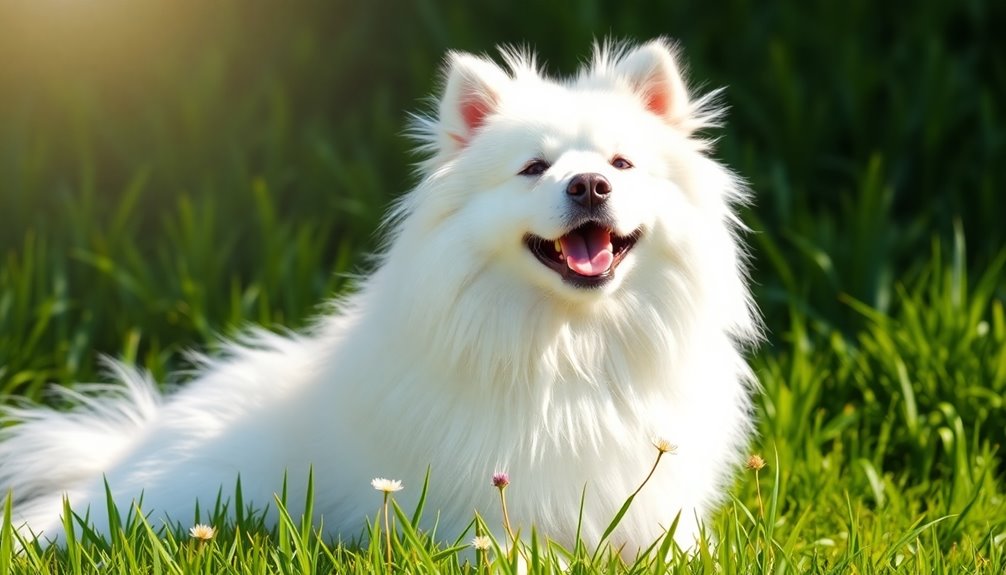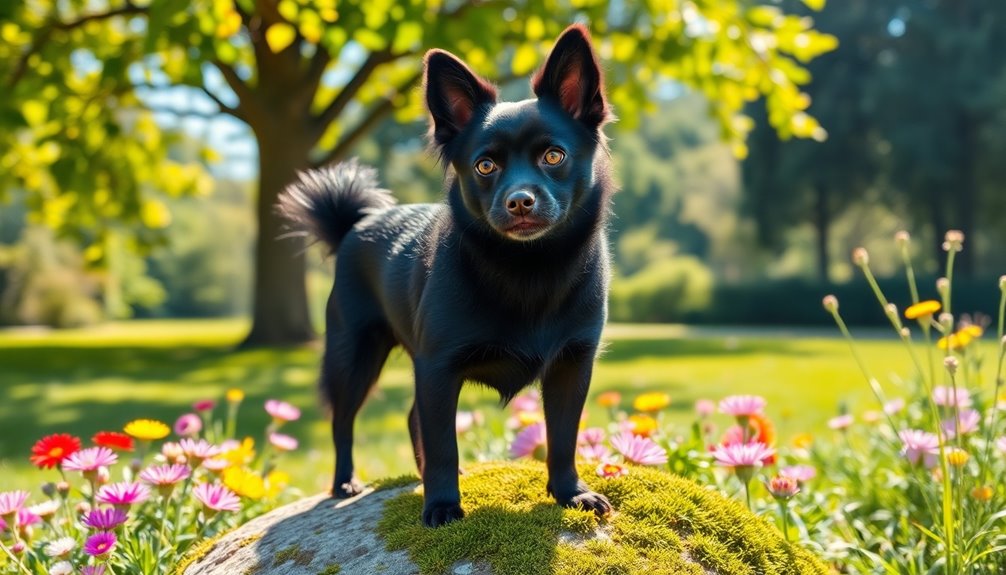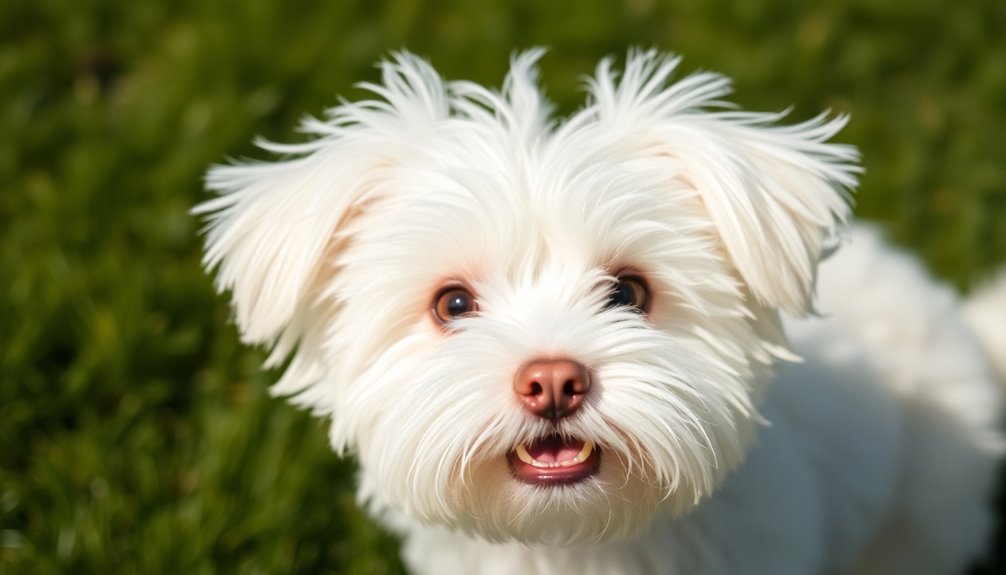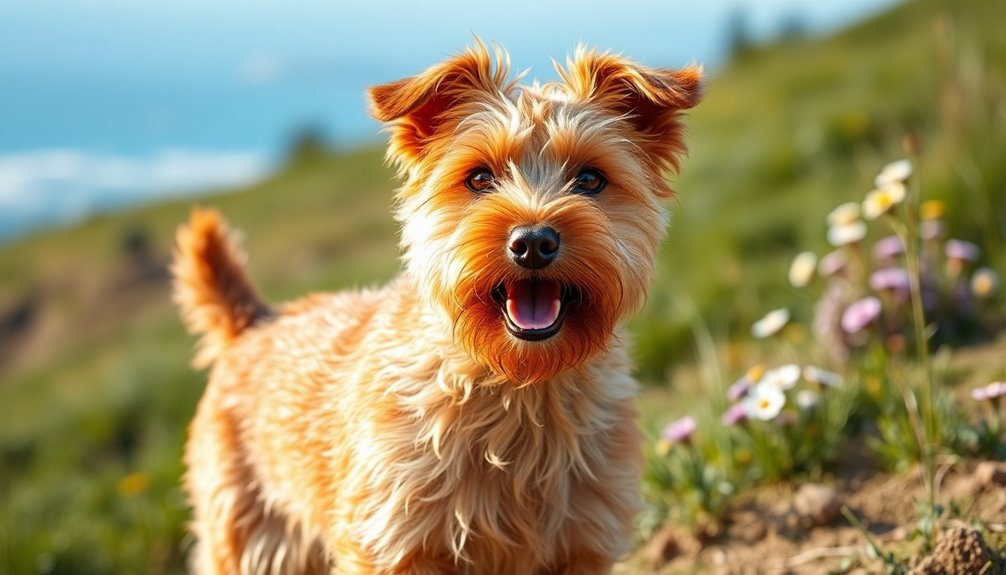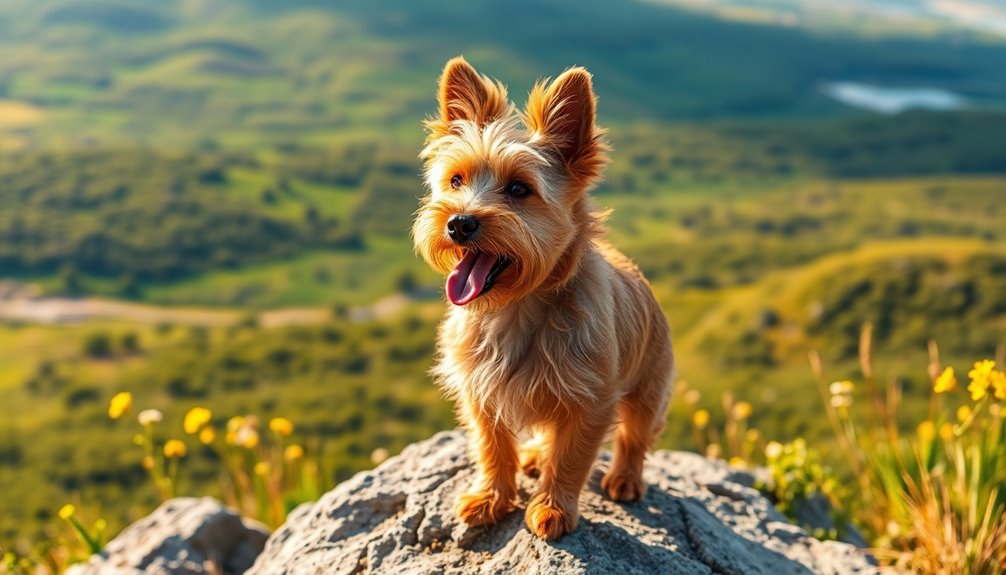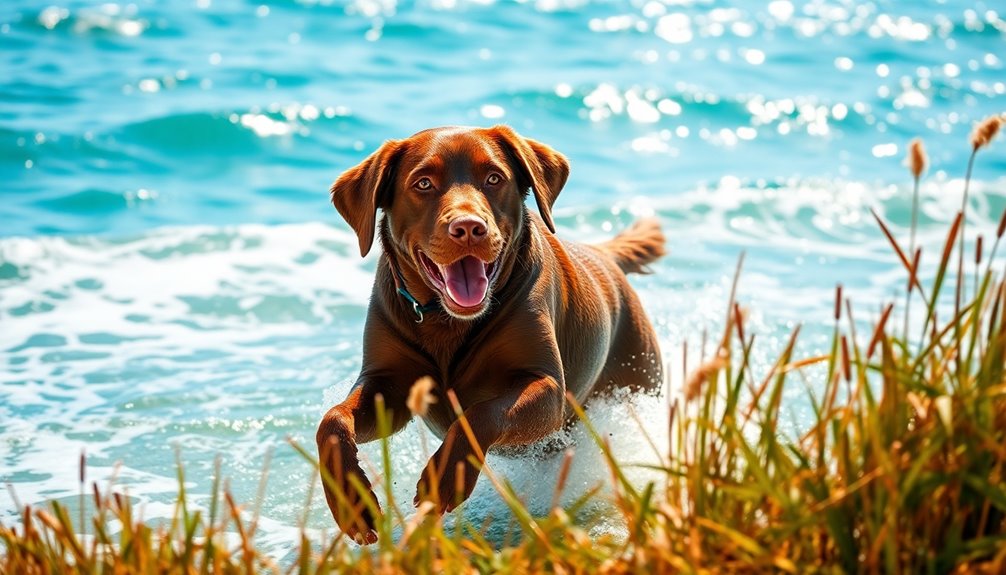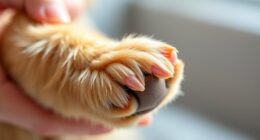The Samoyed, with its cheerful "smile" and fluffy double-layered coat, makes a delightful companion for families and active individuals. These friendly dogs have their roots in Siberia, where they worked with nomadic tribes as herders and sled pullers. Their playful nature and strong emotional awareness make them great with children, but they do need daily exercise and social interaction to thrive. Regular grooming is essential, especially during shedding seasons, to keep their coat healthy. If you're curious about how to care for this joyful breed or their fascinating history, you'll find plenty more interesting details ahead!
Key Takeaways
- Samoyeds are medium to large dogs with a fluffy double-layered coat, known for their friendly and cheerful "smiling" expression.
- Originating from Siberia, they excelled in herding and sled-pulling, showcasing their resilience and adaptability.
- This breed requires daily exercise of 1 to 2 hours, making them ideal companions for active families and individuals.
- Samoyeds thrive on social interaction and companionship, often struggling if left alone for long periods.
- Regular grooming and attention to their health can help manage breed-specific concerns, ensuring a happy and healthy life.
Introduction
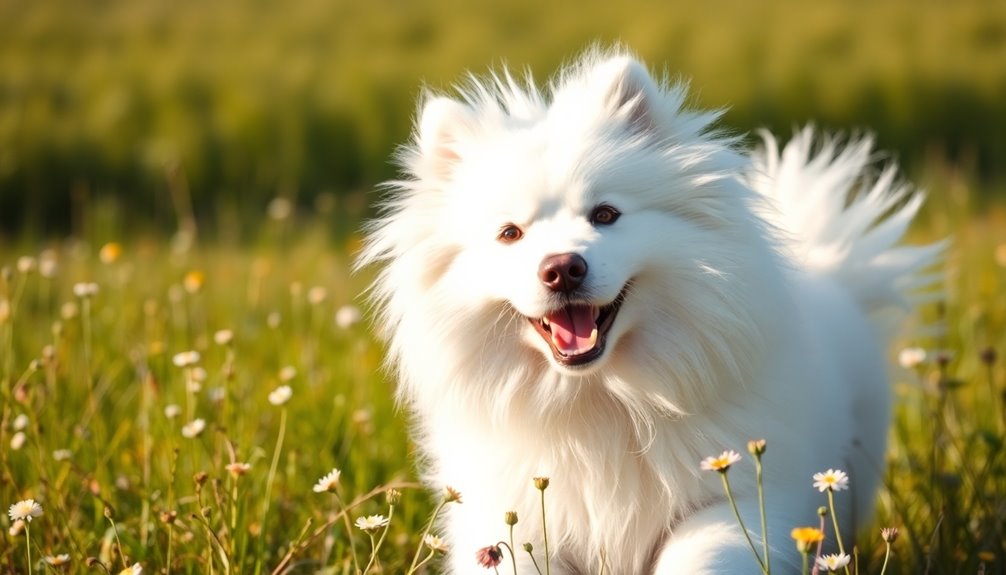
The Samoyed is more than just a strikingly beautiful dog; it's a loyal companion that thrives on human interaction. With a height ranging from 19 to 23.5 inches and a weight between 35 to 65 pounds, these dogs have a sturdy build that's both impressive and inviting.
Their stunning white double coat, featuring a harsh outer layer and a soft, woolly undercoat, requires daily brushing, especially during shedding seasons. You'll appreciate their cheerful demeanor, highlighted by their "smiling" mouths, which means they rarely drool.
Samoyeds have high social needs and a zest for life, needing daily exercise of 20 to 40 minutes to keep them happy and healthy. They're intelligent and enjoy training, making them suitable for various activities like obedience and agility. Regular exercise is crucial for keeping these energetic dogs engaged and preventing boredom.
However, be mindful of their moderate barking tendency; they can become nuisance barkers if left alone for long periods. Their digging habit often stems from seeking a cool spot to rest.
History and Origin
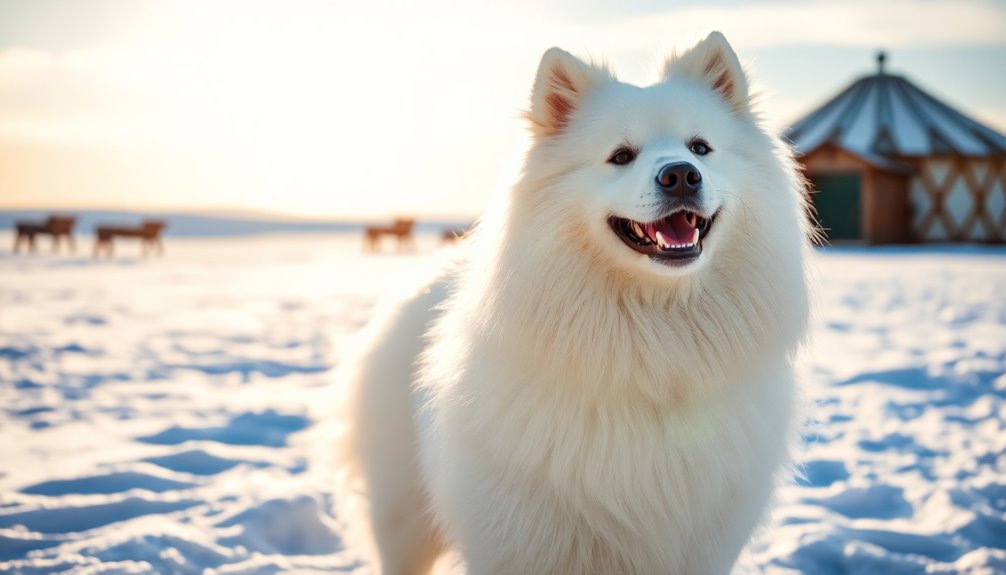
The Samoyed breed traces its roots back to the Russian Lapland around 1000 BCE, where these dogs played vital roles in herding reindeer and pulling sleds for the Samoyedic peoples. You'll find that their endurance and friendly nature made them invaluable companions in harsh climates. The breed is among the most ancient dog breeds globally, with historical presence in Siberia adding to their significance. Understanding their historical significance helps you appreciate the breed's unique traits even more.
Where and when the breed originated
Originating in the northwest region of Siberia, Samoyeds have a rich history tied to the nomadic Samoyedic people who migrated from central Asia around 1000 BCE. These early inhabitants thrived in the harsh Arctic environment, relying on reindeer herding for their livelihood.
Samoyeds descended from the Nenets Herding Laika, a spitz breed known for its resilience and adaptability. Their native land includes the Russian Lapland, the Kola Peninsula, and areas along the Northern Ocean, with their presence extending eastward into the European parts of the Russian North, including the Yenisei River and Taimyr Peninsula.
You'll also find them in the northern regions of the Republic of Komi and the Nenets Autonomous District. Historically, this area was often labeled as the Samoyed region on old maps of the Russian Empire. The breed remained relatively unknown until mid-1800s when European polar explorers first encountered them. These explorers recognized their unique qualities and introduced them to Arctic and Antarctic expeditions.
Over time, Samoyeds gained popularity in England, paving the way for selective breeding programs that would establish the breed as we know it today. Notably, Samoyeds were used for sled pulling during these expeditions, showcasing their strength and endurance in extreme conditions.
Sled Pulling and Herding
Samoyeds have long been celebrated for their incredible capabilities in both sled pulling and herding. Originating in Siberia, these dogs were first utilized as sled dogs in the 1870s by explorers like Nordenskiold. They played crucial roles in Arctic expeditions, including those of Nansen and the Duke of Abruzzi, showcasing their endurance by covering over 100 miles a day with a full sledge.
When reindeer couldn't be used, Samoyeds became essential for towing boats and sledges, proving their value in harsh conditions. Their historical roles as sled dogs highlight the breed's adaptability and strength in extreme environments.
In addition to sled pulling, they were vital for herding reindeer for the Samoyede and Nenets people. They protected herds from predators and supported a nomadic lifestyle, assisting in hunting and guarding. Their training involved commands like "hike" and "mush," with teams of three or four maximizing power.
Today, you might notice their natural instincts can lead to leash pulling issues. Proper training techniques, such as positive reinforcement, can help manage these behaviors while allowing Samoyeds to thrive in modern sled pulling or herding activities.
Their intelligence and endurance make them as capable today as they were centuries ago.
Physical Characteristics
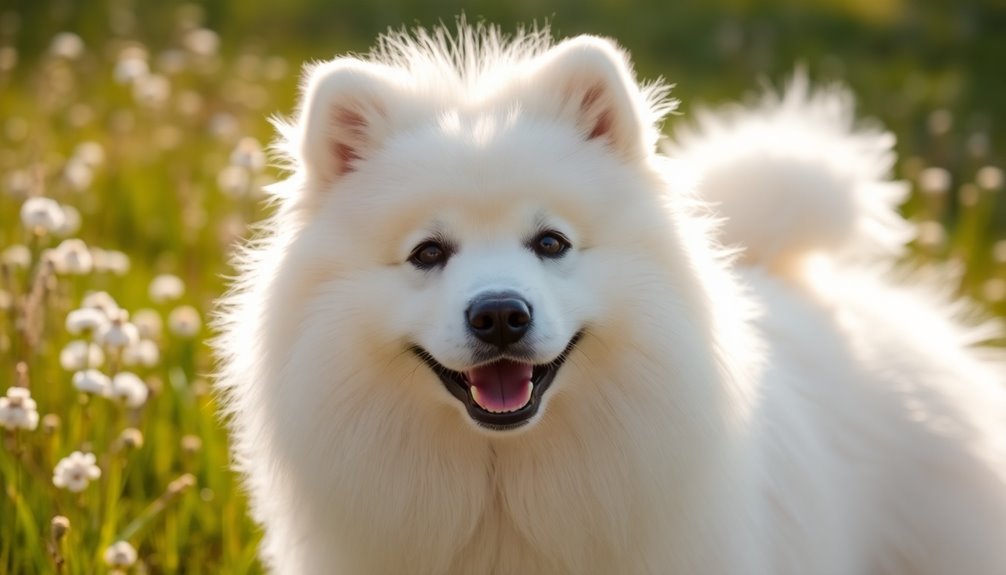
When you think about Samoyeds, their striking physical features come to mind. These dogs typically weigh between 35 to 66 pounds and have a fluffy double-layered coat that keeps them warm in cold climates. Understanding their size and coat characteristics is essential for anyone considering this breed as a companion. Additionally, their height ranges from 19 to 23.5 inches, making them a medium to large-sized breed.
Size, weight, and coat details
Standing out with their impressive stature, Samoyeds exhibit distinct size and weight characteristics that make them easily recognizable. Males typically stand between 21 to 23.5 inches tall, while females are slightly shorter, ranging from 19 to 21 inches. In metric terms, males measure about 53-60 cm and females about 48-53 cm. Adult male Samoyeds typically weigh between 45-60 pounds, while females weigh between 35-50 pounds, giving each a unique presence.
In terms of weight, male Samoyeds weigh between 45 to 65 pounds, while females range from 35 to 50 pounds. This translates to 20-30 kg for males and 16-20 kg for females.
Fluffy Double-Layered Coat
With their fluffy double-layered coat, Samoyeds not only look stunning but also possess a unique physical characteristic that serves multiple purposes. The outer coat features long, coarse guard hairs, while the undercoat is dense, soft, and wooly. This combination keeps your Samoyed warm in cold climates and protects the undercoat from debris and harsh weather. In fact, their thick coat is a reflection of their lineage as a breed that has historically been used for herding and pulling sleds.
You'll notice seasonal shedding, often referred to as "blowing coat," which happens once or twice a year. Females typically shed twice a year, while males shed once. Throughout the year, fine hairs may float around your home, so regular brushing is essential to maintain the coat and minimize shedding.
Occasional baths and grooming tasks, like trimming around the feet, will also help keep your Samoyed looking their best.
Standard coat colors include white, biscuit, and cream, often with beautiful highlights or irregular patches. This striking color combination adds to their distinctive appearance.
The coat's insulating properties even prevent icicles from forming, making Samoyeds well-suited for snowy adventures. Though in warmer climates, you'll need to provide cool, shaded areas for comfort.
Temperament and Personality
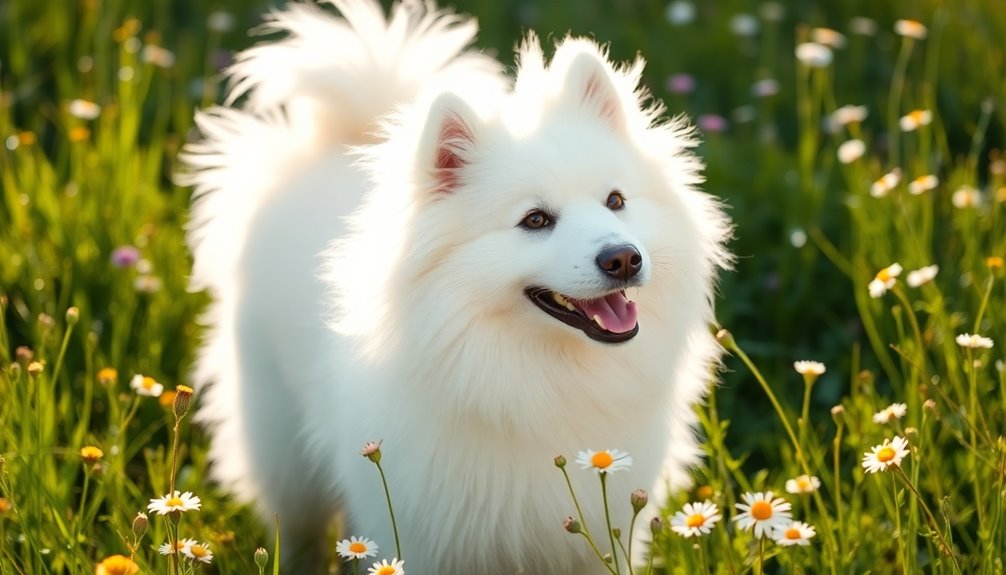
When you think about a Samoyed's temperament, you'll find they're playful and sociable, making them perfect companions for families and individuals alike.
Their friendly nature often extends to children and even strangers, but be mindful if you have other pets, as they may need some introduction. Samoyeds are known for their strong emotional awareness, which allows them to respond to human feelings and interactions, enhancing their bond with their families.
With the right environment and attention, these dogs thrive and bring joy to any home.
Playful and Sociable Demeanor
The joyful spirit of a Samoyed is contagious, embodying a playful and sociable demeanor that makes them exceptional companions. These dogs maintain their playful nature well into old age, always eager to engage in activities that keep them active.
Regular exercise is essential for their happiness; without it, they can become mischievous and destructive. Outdoor adventures like hikes and playtime are where they truly thrive. Samoyeds are known for their high energy levels, making them ideal partners for active families.
Samoyeds are incredibly sociable with humans, displaying a friendly and gentle nature. They love being around people, constantly seeking attention and affection from their families.
Don't be surprised if they greet strangers with warm enthusiasm; their open-heartedness is part of their charm. They don't like being left alone for long, forming strong bonds with their owners and thriving on human interaction.
Intelligent and trainable, Samoyeds are quick learners, making training sessions enjoyable. However, they can be independent and easily distracted, so consistent training is vital.
Their communicative nature shines through their expressive smiles and "talky" tendencies. Samoyeds are sensitive to your emotions, often responding to your feelings with their own unique gestures of affection.
Suitability for families, individuals, or other pets
Samoyeds aren't just playful companions; they also excel in different living situations, making them suitable for families, individuals, and even other pets.
If you have a family, these dogs thrive in dynamic environments, forming strong bonds with children. They require a home where someone's usually around, as they don't fare well when left alone for long periods. Daily exercise is crucial, so be prepared for long walks and playtime in a spacious yard.
For individuals, Samoyeds need companionship and can't be left isolated for too long. They adapt well to changes, like moving to a new home, and flourish with love and consistent care. Early training and socialization are key to developing their positive personality.
When it comes to other pets, Samoyeds generally get along well, especially with those they meet early on. Their history as sled dogs makes them compatible in multi-dog households, provided they're introduced properly.
Health and Lifespan
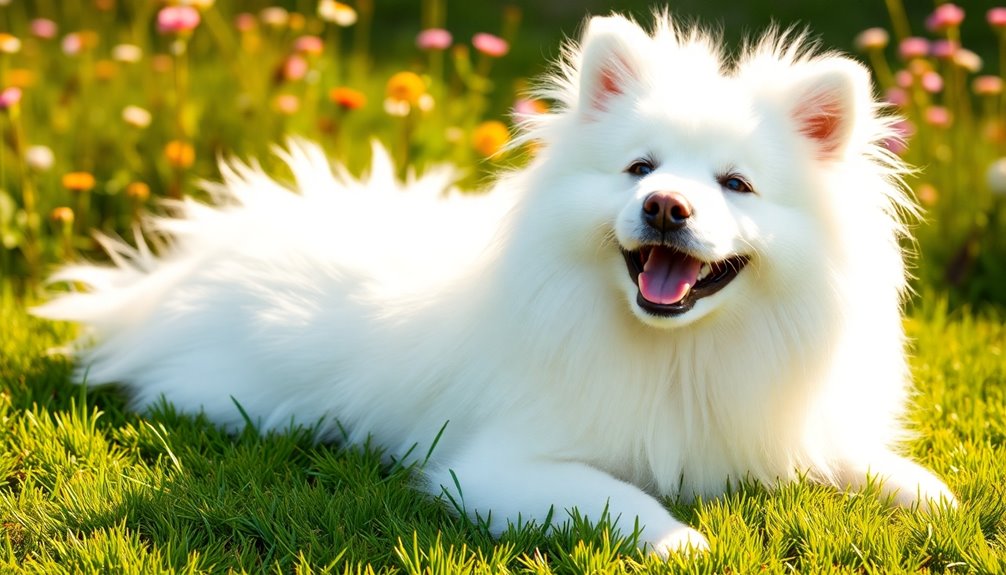
When it comes to your Samoyed's health and lifespan, you'll want to be aware that they typically live between 12 to 14 years. This breed can face common health issues, including genetic predispositions that may affect their well-being. Maintaining a healthy lifestyle through proper diet and exercise is essential for their overall health.
Typical lifespan of the breed
Understanding the typical lifespan of a Samoyed is crucial for potential owners. On average, you can expect your Samoyed to live between 12 to 14 years, but this range can vary based on several factors.
Genetics, overall healthcare, diet, exercise, and living conditions all play significant roles in determining how long your furry friend will be by your side. Proper care can maximize their lifespan, ensuring they enjoy over ten healthy years. Additionally, awareness of breed-specific health risks can help owners take proactive measures to prevent common conditions.
Since Samoyeds are medium to large-sized dogs, their life expectancy aligns with general trends in dog sizes, where larger breeds often have shorter lifespans.
To support your Samoyed's longevity, it's essential to provide regular exercise, a balanced, high-quality diet, and mental stimulation. Daily routines, including grooming and veterinary check-ups, contribute to their well-being.
Pay attention to their sensitivity to warmer temperatures, which can lead to health issues if not managed properly.
Common health concerns or genetic predispositions
A Samoyed's health can significantly influence its lifespan, as this breed is prone to various health concerns and genetic predispositions. One major issue is Uveodermatologic Syndrome (UDS), which can lead to eye inflammation, skin depigmentation, and even blindness if untreated. Symptoms like red or cloudy eyes and excessive tearing are common indicators. Early intervention is crucial for better outcomes in managing UDS symptoms.
Additionally, heart problems such as aortic and pulmonic valve stenosis can strain your dog's heart, necessitating prompt treatment. Regular heart health checks are vital for early detection of murmurs or abnormal rhythms.
Musculoskeletal issues, including hip and elbow dysplasia, can also affect your Samoyed's mobility and quality of life. Obesity exacerbates these problems, making annual screenings important for early management.
On the genetic front, conditions like Samoyed Hereditary Glomerulopathy and diabetes mellitus are prevalent. These can lead to serious complications, so keep an eye out for symptoms like excessive thirst and urination.
Regular urine analyses can help catch kidney issues before they escalate. Understanding these health concerns will help you keep your Samoyed happy and healthy for years to come.
Tips for maintaining health and wellness
Maintaining your Samoyed's health and wellness is essential for a long and happy life together. Start with regular veterinary care; aim for at least one check-up per year. Puppies and seniors may need more frequent visits. Don't skip vaccinations or parasite control, and ensure dental health with routine check-ups and cleanings.
Feed your Samoyed a balanced, high-quality diet that suits their age, size, and activity level. Look for dog food rich in protein, avoiding fillers and artificial additives. A vet-approved balanced diet is crucial for their overall health. Keep fresh water available and monitor their food intake to prevent obesity, aiming for a weight between 45-65 pounds for males and 35-50 pounds for females. Consistent flea, tick, and heartworm prevention is essential for their long-term health.
Daily exercise is crucial—your Samoyed needs at least an hour of physical activity, split into two sessions. Activities like walking, hiking, and games like fetch keep them fit and engaged.
Don't forget grooming! Regular brushing helps manage their thick coat. A vet-recommended grooming schedule can help maintain their coat's health. Ensure your dog is hydrated, changing their water daily. Use flea and tick prevention, along with monthly heartworm medication as advised by your vet.
Following these tips will help your Samoyed thrive and enjoy a healthier, happier life.
Care Requirements
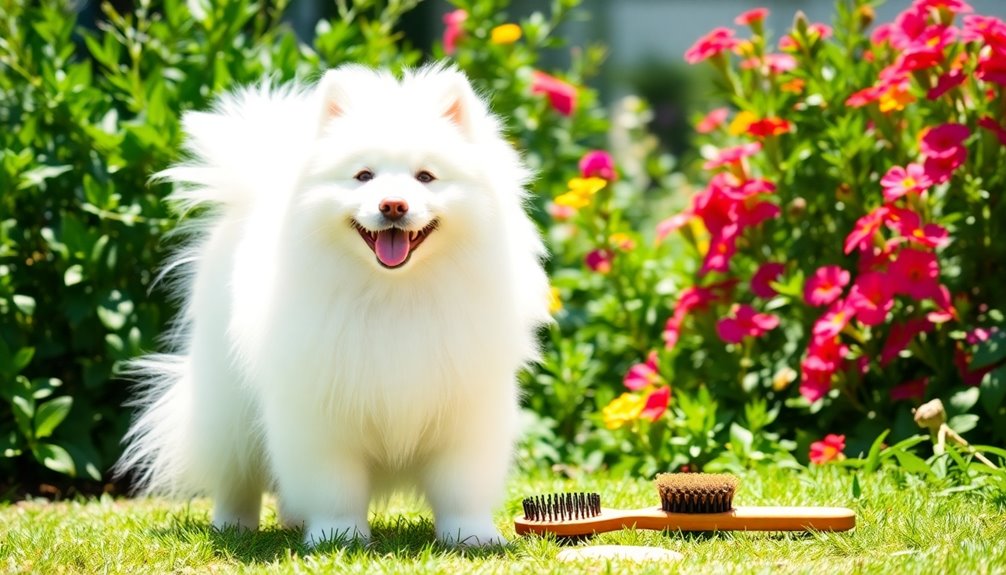
Caring for your Samoyed involves regular brushing to manage that thick coat and prevent matting. You should also prioritize regular ear checks to ensure their overall health. You'll also need to ensure they get plenty of exercise to keep their energy levels in check. Plus, a well-balanced diet is essential for their overall health and coat condition.
Regular Brushing Required
Regular brushing is essential for keeping your Samoyed's thick, double-layered coat in top condition. This breed requires brushing at least 2-3 times a week, and more often during shedding seasons. Regular sessions prevent matting, remove loose fur, and help distribute natural oils throughout the coat, keeping it shiny and healthy.
To effectively groom your Samoyed, use a slicker brush and a metal comb. Brush in the direction of hair growth to avoid irritating their skin, and use a rake or undercoat tool for the undercoat. Pay special attention to areas prone to tangling, such as behind the ears and around the neck, using gentle strokes to prevent discomfort. Additionally, regular brushing can reduce the need for frequent baths, which can strip essential oils from your dog's coat. It also helps regulate your Samoyed's body temperature, maintaining the insulating properties of their fur.
During heavy shedding periods in spring and fall, you may need to increase the frequency of grooming sessions. Keep an eye out for any skin issues while brushing, as early detection can help maintain your dog's overall health.
Exercise requirements and energy levels
A Samoyed's energy levels and exercise needs are crucial for their overall well-being. These dogs require at least an hour of exercise daily, but ideally, you should aim for two hours. Incorporate a mix of leashed walks and more intense activities to keep them fit. Brisk walking suits their stamina, and they thrive in cooler climates, excelling in activities like sledding or urban mushing. Regular participation in CaniCross events allows them to run alongside humans, which is enjoyable for both.
Consider long walks or hikes as part of their routine, and play fetching or frisbee games to add variety. DIY agility courses in your backyard can also offer mental stimulation. Just be cautious about exercising them in temperatures above 70 degrees, as they can overheat easily. In hot weather, limit their exertion to about 15 minutes at a time.
Samoyeds were bred for physical tasks, so regular, vigorous exercise is essential for their happiness. Additionally, keep their minds sharp with structured routines and mental games. Short, focused training sessions of around 5-10 minutes work wonders to maintain their interest and prevent boredom.
Feeding tips and diet recommendations
Feeding your Samoyed properly is vital for their health and vitality. Start with high-quality proteins like chicken, beef, fish, or lamb to support muscle growth. Include balanced fats from sources like fish oil and flaxseed to keep their coat healthy. Complex carbohydrates from whole grains and vegetables will aid digestion and provide sustained energy. Ensuring a diet rich in high-quality protein sources is essential for maintaining their overall health.
For adult Samoyeds, feed 2 to 3 cups of dry dog food daily, split into two meals, adjusting based on age, size, and activity level. Keep an eye on their body condition to maintain the ideal weight. Senior dogs may need fewer calories but more protein for muscle mass, while puppies typically require more frequent meals.
Be cautious with treats—limit them to no more than 10% of daily calories. Healthy options include carrots and lean meats. Always ensure fresh water is available, and consider incorporating wet food for added hydration.
Watch for food allergies and sensitivities, and avoid toxic foods. Smaller, more frequent meals can help prevent bloat, while diets rich in omega fatty acids will promote a shiny, healthy coat.
Following these guidelines will help your Samoyed thrive.
Training and Socialization
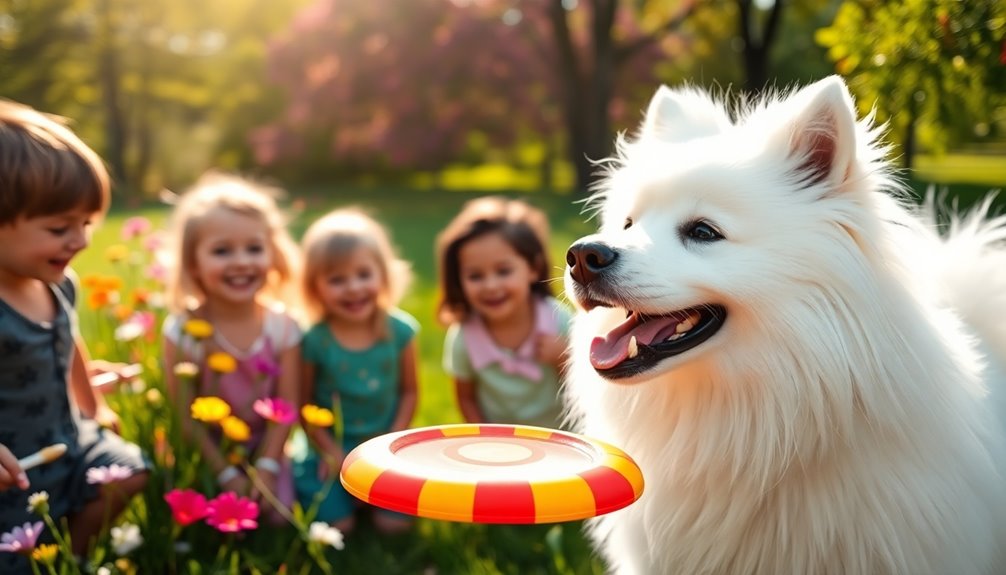
Training your Samoyed requires patience, as their moderate intelligence means they may take a bit longer to grasp commands. Gradual exposure to new environments is crucial to prevent destructive chewing tendencies that stem from boredom or anxiety. Incorporating structured training routines into your daily schedule can enhance their learning and retention of commands.
Moderate Intelligence, Requires Patience
Navigating the training and socialization of Samoyeds requires a blend of patience and understanding, given their moderate intelligence and independent nature. These dogs excel in independent thinking, often making decisions based on their instincts. While this trait stems from their working background, it can sometimes conflict with traditional training commands.
You may find that Samoyeds can be quite stubborn, especially if you're passive during training. To effectively teach them, consistency and clarity in your commands are essential. Keep training sessions engaging and varied to hold their interest; otherwise, they might tune out. Additionally, their unique form of intelligence allows them to navigate treacherous terrains with agility, showcasing their remarkable problem-solving abilities.
Positive reinforcement is key—use treats, praise, and play as rewards for desired behaviors. Early training is beneficial to harness their intelligence, but patience is vital. You might encounter challenges, so be prepared to adapt your methods when needed.
Establishing a consistent routine for housebreaking is also crucial. By creating a calm and enjoyable training environment, you'll foster a stronger bond with your Samoyed. Remember, it's all about patience and persistence, making the training journey a rewarding experience for both of you.
Gradual Exposure to New Environments
Building on the foundation of patience and persistence, gradually exposing your Samoyed to new environments is key to fostering confidence and adaptability. Start in familiar places like your home and backyard, where your dog feels secure. Introduce small changes, such as new items, and consider playing soothing music to keep them relaxed. Reward calm behavior with treats and praise to create positive associations.
As you venture into new areas, begin with quieter sections, like less crowded parks or pet-friendly stores. Expose your Samoyed to various sounds, gradually increasing volume from low to high, including doorbells and car engines. Encourage exploration of different surfaces—grass, sand, or pavement—to help them adapt to new textures. Consistent exposure during these outings contributes to reducing fearfulness and promoting confidence.
Socialization is crucial, so arrange for your dog to meet various people and other animals. Enroll in puppy socialization classes for controlled interactions.
Always monitor your Samoyed's reactions, adjusting stimulation levels as needed. Avoid forcing them into overwhelming situations, and use positive reinforcement to promote a sense of safety. This careful approach will build your Samoyed's confidence and comfort in diverse environments.
Destructive Chewing Tendencies
Understanding the reasons behind your Samoyed's destructive chewing is crucial for addressing the behavior effectively. Many times, this chewing stems from normal play behavior or boredom, especially when left alone for long periods. Your energetic companion, particularly if they're a puppy or an adolescent, may simply need a proper outlet for their excess energy. A lack of exercise can significantly increase your dog's likelihood of becoming destructive.
Remember, this breed has a natural urge to chew, inherited from their wolf ancestors.
To manage this tendency, employ clicker training to reward desired behaviors, associating the click with treats. Implement reward-based reinforcement to encourage good actions instead of punishing unwanted behaviors. Teaching a "drop it" command can also help when your Samoyed picks up off-limits objects.
Make sure their environment is rich in appropriate toys and chews, redirecting their chewing instincts away from household items. Locking them in a controlled area when you're away can prevent destructive behavior.
Consistency is key—maintain a regular training schedule and ensure everyone in the household uses the same methods. Finally, socializing your Samoyed early will expose them to various stimuli, helping reduce anxiety-driven chewing.
Ideal Living Environment
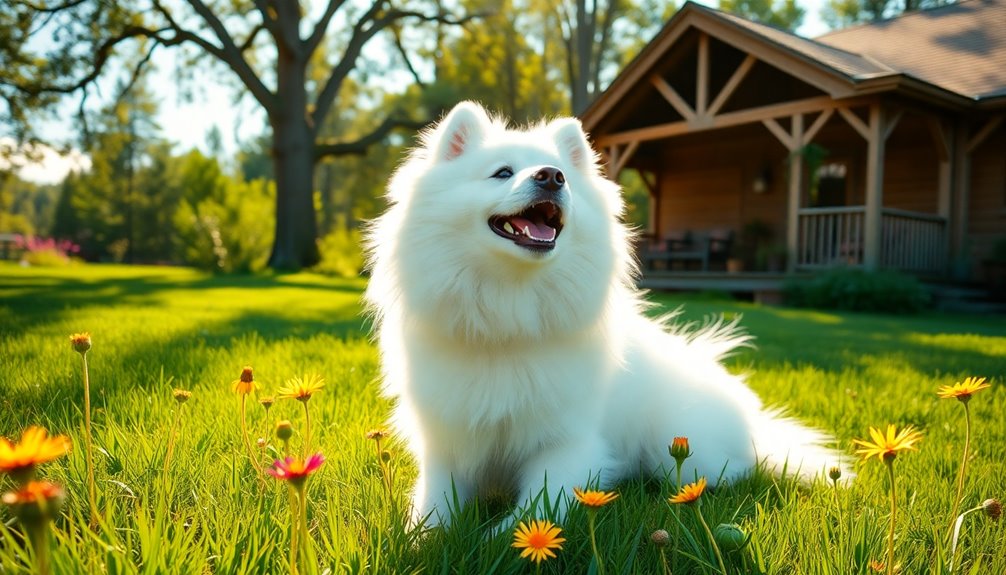
If you're considering bringing a Samoyed into your home, it's crucial to have ample outdoor space for them to thrive. These dogs prefer cooler climates and need access to areas where they can run and play freely. A spacious home with a yard or nearby park will keep your Samoyed happy and healthy. Additionally, they require at least 2 hours of exercise daily to maintain their physical and mental well-being.
Spacious Homes With Outdoor Access
A spacious home with outdoor access is essential for your Samoyed's well-being. These medium to large-sized dogs, weighing between 35 to 65 pounds, thrive in environments that allow them to move freely and engage in physical activities.
If you're living in an apartment, ensure you have a designated area for your Samoyed to rest and sleep, along with enough indoor space for movement.
Your Samoyed needs regular exercise to stay healthy and happy, so daily walks and play sessions are crucial. Aim for at least 30 minutes of exercise each day, and consider letting them play in a fenced yard. This not only meets their physical activity needs but also helps manage their high energy levels. Without outdoor access, your Samoyed might resort to destructive behaviors due to confinement.
Additionally, a fenced yard is vital to prevent them from wandering off. Samoyeds are social animals that crave companionship; outdoor time reduces barking and keeps them engaged. Providing opportunities for early socialization can also enhance their adaptability to different environments.
Ultimately, providing a spacious home with outdoor access enriches your Samoyed's life and strengthens your bond.
Prefers Cooler Climates Over Heat
Providing a spacious home with outdoor access helps your Samoyed thrive, but the environment's temperature plays a significant role in their happiness. Originally bred in Siberia, Samoyeds are well-adapted to cold climates. Their thick, double-layered coat provides excellent insulation, allowing them to maintain body temperature and energy levels even in harsh, frigid conditions. Regular monitoring is essential to ensure their well-being in extreme conditions, as they can be at risk for frostbite and hypothermia if exposed for too long.
However, their dense fur poses challenges in hot weather. In warmer temperatures, your Samoyed will struggle, needing plenty of shade, fresh water, and air-conditioned spaces to stay comfortable. Limit exercise during the hottest parts of the day to prevent heat-related issues. You should also ensure they've cool spots to lie down and monitor them closely for signs of overexertion or heat exhaustion.
If you live in a warm climate, gradually acclimatize your Samoyed to the heat while providing ample grooming to allow for better air circulation. Keep in mind that their dietary needs may change with the seasons, requiring more calories in colder weather.
Regular veterinary check-ups will help you keep track of their health, ensuring your fluffy companion remains happy and comfortable.
Samoyeds Were Once Sled Dogs
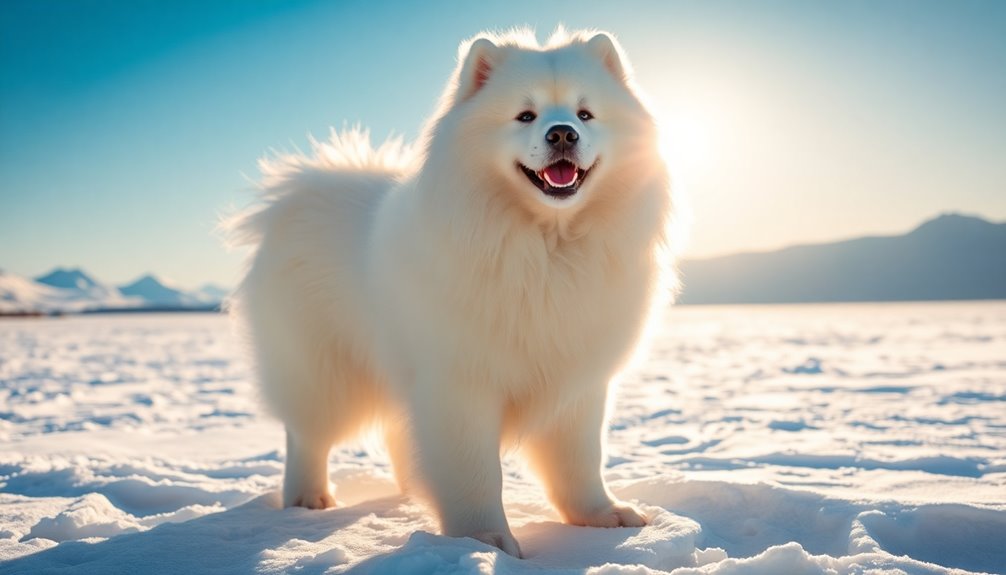
Samoyeds weren't just adorable companions; they were bred for extreme cold endurance as sled dogs in harsh Arctic climates.
Their strength and resilience made them famous in historical explorations, assisting pioneers like Fridtjof Nansen and Roald Amundsen. Their high energy levels necessitate regular exercise and mental stimulation, which is essential for their overall well-being.
Understanding their sledding heritage gives you a glimpse into the remarkable capabilities of this breed.
Bred for Extreme Cold Endurance
While originally bred for their remarkable cold endurance, these dogs played a crucial role in the lives of the Samoyedic peoples of Siberia. Samoyeds descended from the Nenets Herding Laika and were invaluable for herding reindeer, pulling sleds, and providing warmth in harsh Arctic conditions.
Their thick, fluffy white coats, featuring long guard hairs and a dense woolly undercoat, kept them insulated against extreme cold, allowing them to thrive in temperatures as low as -60°F. Their double coat not only protected against harsh elements but also allowed them to comfortably sleep in the snow.
With their strong, muscular build, Samoyeds excelled at pulling sleds for long hours, demonstrating incredible endurance. Unlike horses or mules, they required less food and could withstand severe weather, making them the ideal draft animals.
These dogs weren't just working animals; they lived closely with their human families, keeping children warm and safe. Their friendly and gentle nature made them perfect companions, and their playful spirits thrived on human interaction.
With proper care, regular grooming, and exercise, these resilient pups continue to embody the spirit of endurance and companionship.
Famous in Arctic Exploration
The remarkable endurance and adaptability of Samoyeds made them invaluable not just to the Samoyedic peoples but also to explorers venturing into the Arctic and Antarctic regions.
Originating as sled dogs in Siberia, these loyal companions helped with reindeer herding, polar bear hunting, and guarding belongings. When reindeer were scarce, they even towed boats and sledges, proving their versatility. Samoyeds were also known for their intelligence and endurance, which made them exceptional working dogs in extreme environments.
Prominent explorers like Nansen, Nordenskiold, and Shackleton relied on Samoyed teams during their historic expeditions. For instance, during Nansen's Farthest North expedition, these incredible dogs covered over 100 miles in a single day with fully loaded sleds, showcasing their strength and endurance.
Their performances were essential for survival in harsh polar conditions.
Samoyeds were part of significant expeditions, including the first ship journey to the North Pole and missions by Amundsen and Borchgrevink.
Their courage and reliability earned them a lasting reputation as invaluable sled dogs.
Today, many modern Samoyeds trace their lineage back to these veteran sled dogs, reminding us of their remarkable contributions to exploration and their enduring legacy in both companionship and adventure.
Ideal for Active Lifestyles?
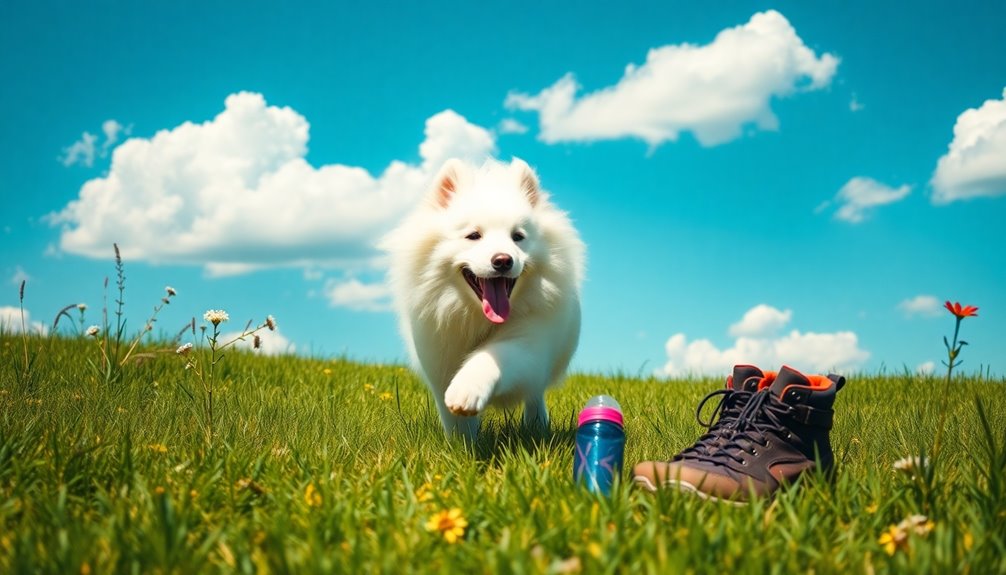
If you lead an active lifestyle, a Samoyed could be the perfect companion for your family.
Their high energy levels and love for outdoor activities mean they'll thrive in a home where they can join in on adventures. Just keep in mind that their grooming needs require regular attention to keep them looking their best. Regular exercise helps prevent behavioral issues that can arise from boredom, making it essential to incorporate daily activities into your routine.
Great for Active Families
For families that enjoy an active lifestyle, a Samoyed makes an excellent companion. These dogs thrive on at least 1.5 to 2 hours of daily exercise, which can include long walks, hikes, and trips to the dog park. Their high endurance means they can keep up with your family's adventures, whether you're exploring a new trail or playing fetch in the backyard. Vertical lists enhance structure and flow in documentation, allowing for clear organization of activities suitable for Samoyeds.
Samoyeds require both physical and mental stimulation, so incorporating interactive games and DIY agility courses can help prevent boredom and potential destructive behavior. They love engaging in activities like urban mushing or running, especially in cooler climates.
These playful and adventurous dogs fit perfectly into family dynamics, enjoying social interaction with both adults and older children. Their loyal and friendly nature makes them great companions for everyone, as long as they receive the attention they crave.
If you're an active family, a Samoyed will eagerly join you in all your outdoor pursuits, ensuring that each activity is filled with joy and companionship. Just remember to keep an eye on the temperature, as they prefer cooler weather for their exercise!
Grooming Needs and Maintenance
Keeping a Samoyed's coat in top condition is essential, especially for families that lead active lifestyles. Regular brushing, ideally a few times a week, prevents matting and removes loose fur. Use a slicker brush and a metal comb, brushing in the direction of hair growth to avoid skin irritation. It's important to note that regular grooming can help prevent other issues, such as skin irritations and infections.
During shedding seasons, increase your brushing frequency to daily and employ an undercoat rake to manage the thick undercoat. This is particularly important because they have a thick double coat that requires regular attention to stay healthy.
Bathing isn't needed often—every 3-4 months is sufficient unless they get dirty. Use dog-friendly, hypoallergenic shampoos to preserve their coat's natural oils and avoid dry skin. Always dry their coat thoroughly after bathing to prevent skin issues.
Don't forget about nail and dental care. Trim toenails every three weeks and brush their teeth 2-3 times a week with dog-safe toothpaste. Check regularly for skin issues like redness or bumps.
Finally, avoid shaving your Samoyed, as it can disrupt their ability to regulate body temperature. Instead, rub them down with a wet towel between baths, and ensure they've plenty of shade to protect their coat from sunburn. Regular attention to their grooming needs helps maintain a healthy and happy pet.
Frequently Asked Questions
Are Samoyeds Good With Children and Other Pets?
Yes, Samoyeds are great with children and other pets! Their gentle and affectionate nature makes them wonderful companions for kids.
Just ensure you supervise interactions to keep things safe and monitor their behavior.
With proper training and socialization, they can also coexist happily with other pets. Introduce them gradually and create a calm environment.
Ultimately, you'll find that Samoyeds can form strong, loving bonds with your family and furry friends.
How Much Do Samoyeds Typically Weigh?
Samoyeds typically weigh between 35 to 60 pounds, depending on whether they're male or female.
Males usually range from 45 to 60 pounds, while females weigh between 35 and 50 pounds.
Keep in mind that these dogs can appear larger due to their fluffy coats.
By the time they reach 12 months, most will hit their full weight.
Monitoring their diet and exercise is essential to maintain a healthy weight.
What Is the Average Cost of a Samoyed Puppy?
The average cost of a Samoyed puppy ranges from $1,500 to $3,000 when you buy from reputable breeders.
Prices can vary based on location, breeder reputation, and the puppy's pedigree. For instance, in the Midwest, you might pay between $2,000 and $3,700.
If you're considering adopting, shelters often charge $200 to $500, making it a more affordable option.
Remember to factor in additional costs for supplies and ongoing care!
Do Samoyeds Shed a Lot?
Yes, Samoyeds do shed a lot. They shed year-round, with heavier shedding during spring and autumn.
You'll notice their soft undercoat coming out, especially during these peak shedding seasons. To manage this, you'll need to groom them regularly—ideally every other day.
Using the right grooming tools can help keep their coat clean and minimize loose fur around your home. A good diet can also help control the amount they shed.
Can Samoyeds Live in Apartments?
Yes, Samoyeds can live in apartments, but you'll need to ensure they get enough exercise and mental stimulation.
Create a cozy space for them to rest, and keep your apartment bright and well-ventilated. Daily walks and playtime are essential to prevent boredom and destructive behavior.
Make sure to socialize them and train them to manage their vocal tendencies, as they thrive on companionship and can struggle with being alone for long periods.
Conclusion
In conclusion, the Samoyed is more than just a fluffy companion; they're a joyful, active breed that thrives on companionship and adventure. Their rich history as sled dogs makes them perfect for those who love the outdoors and an active lifestyle. With proper training and socialization, you'll find a loyal friend who's always ready to share a smile. If you're looking for a playful and affectionate partner, a Samoyed might just be your ideal match!

